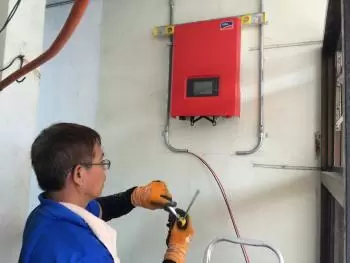
The balance of system (also known by the acronym BOS) includes all the photovoltaic system components except for the photovoltaic panels.
We can think of a complete photovoltaic energy system of three subsystems when we speak about solar energy.
-
On the power generation side, a subsystem of photovoltaic devices (solar cells, PV modules, arrays) converts sunlight into direct current (DC) electricity.
-
On the energy use side, the subsystem consists mainly of charging, which is the application of photovoltaic electricity.
-
Between these two, we need a third subsystem that allows the electricity generated by the photovoltaic modules to be applied correctly to the load. This third subsystem is often called the "balance of the system" or BOS.
A grid-connected system requires system balancing equipment that allows you to safely transmit electricity to your loads and meet the grid connection requirements of your power provider.
The law of conservation of energy states that energy does not disappear. However, if the BOS is not correctly dimensioned, part of this energy is transformed into heat lost due to inefficiencies.
What elements make up the balance sheet?
The balance of the system is constituted, in general terms:
-
Batteries: In some systems isolated from the grid, the electricity generated cannot be supplied to the electricity grid. In these cases, the energy is stored as chemical energy in batteries or similar elements. Chemical engineering allows you to store electrical energy through chemical reactions in one.
-
The control unit centralizes all the information about the solar facility.
-
The current inverter is electronic equipment that modulates and transforms the electric current generated by the PV panels. The PV panels supply DC, and the inverter converts it into AC electricity.
-
Charge regulator to prevent voltage from exceeding system limits.
-
The mechanical supporting structure.
-
The electrical wiring must be correctly dimensioned for the required current intensity and avoid energy losses due to Ohm's law.
-
Protection devices (fuses, earth leads, and wiring switches).
A BOS solar system balance may also include the following components:
-
Monitoring of the maximum power point tracking (MPPT)
-
GPS solar tracker to calculate the best inclination and orientation of the solar panels.
-
Power management software is software to control de well-working of all the facility parts.
-
Solar concentrators: The concentrators allow concentrating solar radiation at a single point using mirrors.
-
Solar radiation sensors.
-
Wind equipment.
-
Task-specific accessories are designed to meet the specialized needs of a system owner.
-
Additionally, concentrating solar PV systems require optical lenses or mirrors and sometimes a cooling system.
In addition, a large above-ground solar photovoltaic power station requires equipment and facilities, such as:
-
Connections to the network to the electrical grid to discharge the excess energy.
-
Office and concrete installations to manage the solar installation.
Depending on the mounting system, the BOS components may include the land as a ground-mounted plant.
How much does the balance of the system cost?
The cost of the BOS will include the cost of hardware (and software, if applicable), labor, connections and inspection fees, and any other fees that apply. For large commercial solar systems, the cost of BOS can include the cost of land and construction, etc.
To get an idea of the cost of the balance of the photovoltaic system (BOS solar), the photovoltaic modules represent approximately 25% of the total cost. However, if it is a closed system, the cost of batteries is usually higher than that of photovoltaic panels, especially if periodic replacement is included.
So even if the modules were free, we would only reduce the cost of isolated stations by 25%.
Fortunately, many applications do not need accumulators (water pumping, irrigation, grid connection) and are free of this economic burden.
What is the BOS charge controller?
The charge controller is a device that regulates the flow rates of electricity from the source to the battery bank and its load.
The controller keeps the battery fully charged without overcharging it. When the load consumes power, the controller allows the load to flow from the generation source to the battery, the load, or both.
When the battery charger detects that the battery is entirely (or nearly fully) charged, it reduces or stops the flow of electricity from the generating source. As an alternative, it may divert it to an auxiliary or "bypass" load. This solution is much more frequent in an electric water heater.
Many controllers will also detect when the loads have drawn too much power from the batteries and stop the flow until sufficient charge is restored. This last feature can significantly extend battery life.
What is the balance of plant (BOP)?
Balance of plant (BOP) is a term generally used in the context of power engineering to refer to all the supporting components and auxiliary systems of a power plant necessary to deliver the energy, in addition to the generating unit itself.
These can include transformers, solar inverters, support structures, etc., depending on the type of plant.